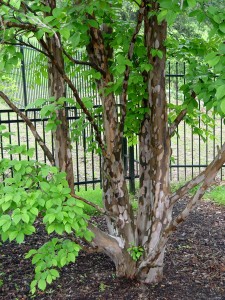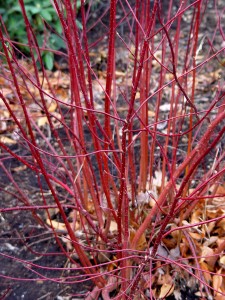Cool Bark Gives Bite to the Winter Garden
February 17th, 2005
One thing I keep hearing from home gardeners is that most everyone wants a yard that looks good in all four seasons.
That’s fairly easy to pull off in three of the seasons, but in winter?
It’s a bit more challenging when the plant palette consists mainly of evergreens, a few berried shrubs, semi-drooping clumps of browned-out ornamental grasses and a handful of perennial flowers that manage to maintain green leaves when snow isn’t body-slamming them.
The only other feature in our winter bag of landscape tricks is interesting bark on trees and shrubs.
Granted, it’s not the glaring splendor of a dogwood in full bloom, but some barks can be pretty impressive – especially when there’s little else to distract you.
A few species have enough bite in their bark to carry a big chunk of the winter-landscape load. Once in awhile, it’s the bark alone that makes us want to plant a species.
That’s certainly the case with the white birch (Betula papyrifera), a multi-trunked tree beloved for its thin, peeling, white bark. This bark is so striking – especially when the leafless tree is surrounded by new snow – that it’s heavily planted despite having a messy seed drop and a propensity for borers, leaf miners and Septoria leaf-spot disease.
Just as good a peeler but far less used is the paperbark maple (Acer griseum), a single-trunk, 25-foot maple with cinnamon/russet peeling bark. These make gorgeous specimens for small to mid-sized yards and seldom have any bug or disease problems.
Birches besides the white birch and the even more trouble-prone European white birch (Betula pendula) have peeling bark. One of the best is the native river birch (Betula nigra).
River birches also peel like crazy but in a cinnamon color. The variety ‘Heritage’ is especially bug- and disease-resistant, and ‘Dura-Heat’ is equally tough but with more whitish peeling bark.
Some trees’ bark peels off in a more subdued way to leave behind a mottled look – somewhat akin to a Dalmatian’s skin. This is more of a flaking, and when it first happens, unaware gardeners assume something is going dreadfully wrong.
The most beautiful example is the stewartia. I can’t avoid taking a picture every time I see the mature bark on one of these largely unknown, under-used trees.

Bark of Japanese stewartia.
Not only do stewartias have a blend of brown, tan and cream mottled bark, they get camellia-like white flowers in summer and some of the brightest, eye-popping fall foliage this side of maples.
Japanese stewartia (Stewartia pseudocamellia) grow about 25 feet tall, and Korean stewartia (Stewartia koreana) are a little smaller but a little more forgiving about growing conditions.
Similar in mottled beauty is the Persian parrotia (Parrotia persica), another small and little-known species that has spectacular golden late-fall foliage. Parrotias grow as single-trunk or multi-stemmed trees that top out around 30 feet tall.
A third super “mottler” is the Kousa dogwood (Cornus kousa), a Chinese import that flowers a month later than the American dogwood (in June) and grows more horizontally. The bark looks a lot like a black-and-white spotted Dalmatian.
Kousa dogwoods also are more bug-, disease- and clay-soil-resistant than American dogwoods, and they get gobs of red-orange, warty, marble-sized fruits in fall that birds love.
If winters were kinder to us, crape myrtles (Lagerstroemia) would give us one more great mottled choice. These small summer-blooming Southern favorites have beautiful smooth, mottled bark when mature, but the trouble here is that we usually can’t get to the mature size.
Even the newer Pennsylvania-hardy crape myrtles occasionally die back to the ground in unusually cold winters. New shoots grow back, but the mottling has to start all over.
All of this peeling and flaking isn’t done for our winter amusement. It’s a way some trees cope with the fact that their outer bark is dead while the inside of the tree continues to grow. It’s similar to how we slough off old skin.
Bark can be beautiful even when it’s not peeling or flaking.
Who can resist stroking the smooth, gray bark of a century-old European beech (Fagus sylvatica)? These always remind me of a giant elephant leg.
Then there’s the furrowed look of the white oak (Quercus alba), the shiny, striped bark of cherries (Prunus) and the rusty, shredded bark of the dawn redwood (Metasequoia glyptostroboides)… all cool in their own way.
But if it’s color you must have, a few barks come to the rescue.

Red stems of a red-twig dogwood in winter.
Best known are the red-twig and yellow-twig dogwoods — multi-stemmed shrub forms of the dogwood family. The leaves of these 6-footers drop in fall to reveal pencil-thick whips of bright red and bright gold that particularly glow with an evergreen backdrop.
Also check out the coralbark maple (Acer palmatum ‘Sango Kaku’). This small, upright version of Japanese maple has young stems that are a bright coral/red.
Consider planting your barked favorites where you can see them out a window.
That way you can enjoy them without freezing your bark off.
A FEW OTHERS…
Five more woody plants with interesting winter bark that do well in central Pennsylvania:
* Yellowwood (Cladrastis kentukea). 50-foot shade tree with smooth, gray bark. Sun or part shade.
* Paperbark cherry (Prunus serrula). 20-foot tree with peeling cinnamon-colored bark.
* Sycamore (Platanus occidentalis). Large shade tree with flaking white bark. Sun or part shade.
* Lacebark pine (Pinus bungeana). 30-foot evergreen with brown/white/green mottled bark. Full sun.
* Willows (Salix species). 20- to 30-foot multi-stemmed trees with golden, scarlet or coral bark, depending on species. Prefers damp soil, sun or part shade.







